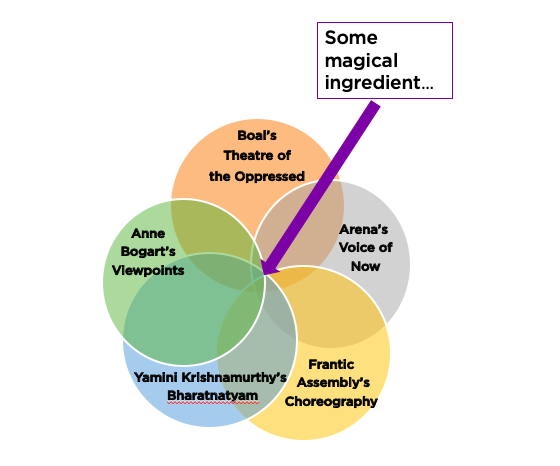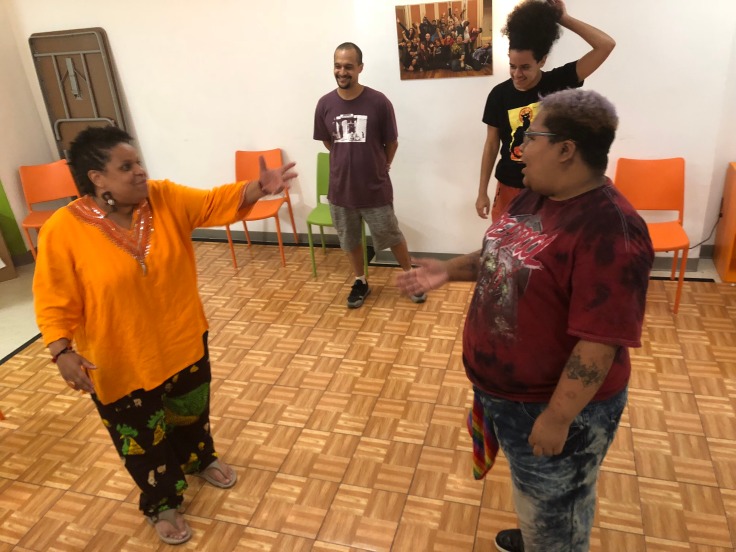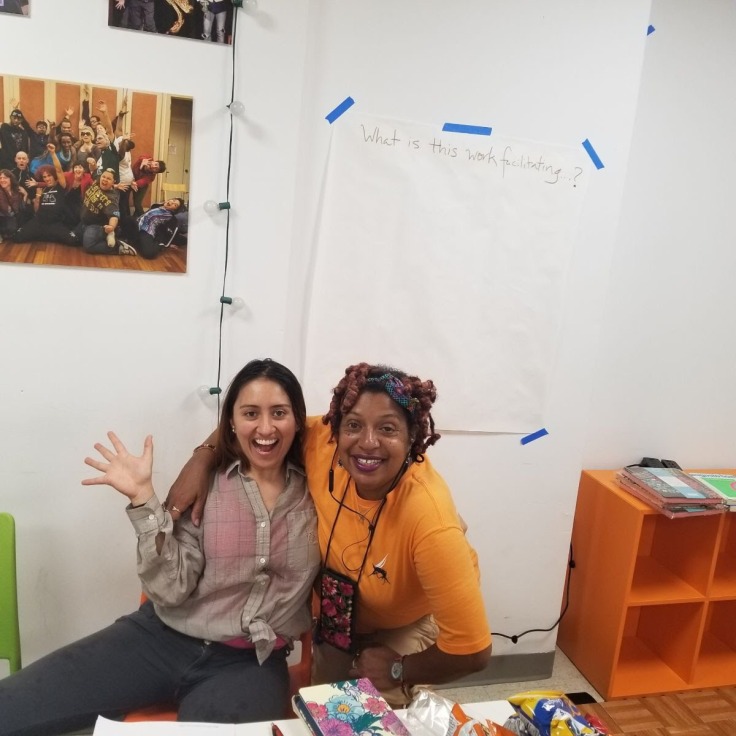The U.S. government has spoken. My visa is nearing its end and so my bags are packed and apartment cleaned. I am saying farewell to the U.S and all my workshop participants and teachers here who engaged me, challenged me, and opened me up to a world of applied theatre that I never knew existed. While I feel in someway incomplete about leaving behind spaces that taught me so much, I also feel this strange churning in my belly. A churning that is pushing me to synthesise all these practices to create something new, maybe a new… system, ensemble, process, curriculum, workshop, company, cross-cultural mish mash of…..games?

Why? I have EXPERIENCED principles of performance transform different populations in someway or the other. When body shapes and gestures create complex stories I see the eyes of the audience widen and the actors straighten their spine. There is a universal connect in these different performance practices and that is why they are effective in stimulating audiences. But what is that magical universal ingredient? I feel like I have my finger on it….almost, if only I can identify it, pull it out and apply it back home. Maybe I should wait to get to India before I jump on this wagon? Maybe observe how things are in a country I left 5 years ago before I start thinking ahead? But will I forget all these games that I have learned if I expose myself to something new? Or are these methodologies already (unconsciously) in my muscle memory….?
This blog has been one way for me to track my own learnings but maybe I need to take these words beyond my laptop screen and do something in Delhi. I don’t know how or where or when but if theatre has so many different applications within Boal’s methodology, then there MUST be other ways of adapting it/pouring it/structuring it for a community that might need it. A community I can stick with for the long haul to measure the change that theatre can create.
One community that is creating tangible change through Boal’s work is Theatre of the Oppressed NYC (TONYC). This troupe comprises of members from local organisations who devise and perform plays based on their challenges confronting economic inequality, racism, and other social, health and human rights injustices. After each performance, actors and audiences engage in theatrical brainstorming in the form of Boal’s Forum Theatre with the aim of catalyzing creative change on the individual, community, and political levels.

I was lucky enough to meet Max and Liz – Jokers of TONYC at the PTO Conference earlier this year. Before I departed the U.S I knew I had to meet this group and first hand experience how they have engaged communities facing oppression, trained them to joker and perform over 60 forum theatre public performances that have lead to legislative policy changes.
Not only were Max and Liz kind enough to let me see their headquarters but also invited me to facilitate a session with 15 TONYC Jokers. As someone who was experiencing a sense of alienation in this country, I was curious to explore narratives of the same with socially conscious communities in the U.S. This was also the first time I was going to facilitate a workshop where I was not the only Boal expert in the room and I was brimming with excitement. What new can exercises can TONYC and I explore together on this hot summer afternoon in New York?
In my last post I mentioned how I felt limited by the use of lengthy dialogues in Forum Theatre. Not only does the Joker clearly articulate the proceedings of the show for the audience to understand the format but also the actors end up relying on scripted dialogue interactions to clearly voice their internal complexities to the audience. So I decided to take on the challenge to facilitate a non-verbal Theatre of the Oppressed session with TONYC. I combined some wordless warm ups from Voices of Now and Viewpoints to understand systematic oppressions. I also thought that this might bring me closer to that magical ingredient between Boal’s work, physical theatre, dance, devised theatre, and …
Below is the description of the workshop I sent to Liz:
Through games, warm ups and choreography, participants will explore Boal’s Theatre of the Oppressed. The purpose of these highly physical warm ups is to strengthen flexibility in imagination, concentration, physical freedom, and ensemble collaboration. The workshop will culminate in the creation of silent short movement pieces, no longer than one-to-two minutes, with a strong image of oppression that viewers can easily understand, identify, and apply to their own lives. There will be a focus on the power dynamics between the oppressor and the oppressed, which are central to Boal’s image theatre scenes. Participants will learn that their bodies are powerful mediums of communication; even with no talking the audience can be pulled in immediately because they know exactly what is being said. They will also be exposed to how movement, music and choreography are used to heighten the impact of gestures and visuals – a skill they can apply to future TO work with their own communities.
(Please email me if you want to see the whole curriculum)
When I arrived at TONYC I couldn’t believe they had acquired such a beautiful office cum studio space in the heart of New York City. The walls were filled with posters from their shows and conferences. There was an office near the training room where people were passionately talking about their TO practices from all over the world (India included!). I knew I was going to learn so much from this organisation.

A C C E S S!
Access to different abilities: Though I came with a kitty of physical exercises I soon realised that not all my exercises catered to all abilities. For example – I started the session with a Voices of Now game called “Draw your name in the Sky” in which participants had to stand in a circle and embody a letter from their name. While this game is usually a great way to open up a group (as I have seen with children) it requires participants to stand in a circle for a long time. This activity had the Jokers feeling restless. Many of them began to slide into chairs and move towards the wall. Some even voiced that they had injuries and were unable to stand for too long. Knowing that the rest of the workshop would also require movement I introduced chairs into this exercise so people, if they wanted, could use hands/fingers to draw out their names. For those who were able to do the full body movement, they could push their chairs aside. As a facilitator, it was important for me to create opportunities for modifications based on people’s abilities. I also will be more conscious when designing workshops next time – ensuring that each activity allows for some variation in methodology – it can’t be too movement heavy or too verbal. There is a fine middle ground.
Access to different identities: Never before have I been so aware of my identity as an Indian facilitator in the U.S. Given that many of the participants were exposed to Boal’s methodologies and were active change-makers in their communities, the images that emerged in the exercises were rich and intimately connected to intersections in their identity – their race, their gender, their sexual orientation etc. Quite naturally, the group began to Joker each other, asking questions about the housing crisis and the school-to-prison pipeline problem and its impact on non-conforming identities of color in New York. While I felt like an outsider in many ways – someone who was unaware of the depth of these issues – I also found myself reflecting on my own intersections as a facilitator (or more…a listener). Here I was, an international student who came to the U.S to study theatre and found herself using theatre to plug into communities of all ages and background to address complex, (sometimes) culture-specific, systematic narratives, now on a ticking visa-expiry deadline to fly home. But also I know that this is just ONE narrative and ONE way of looking at my own identity.
I am also (now I can say confidently) a Theatre of the Oppressed practitioner and I wonder how that identity will shift as I plug into a different community at home. What will it mean to now leave these stories and immerse myself in Delhi? What communities and contradictions will I find there and where will I place myself in them? Will my moments of connection with communities change through the practice of Theatre of the Oppressed? Will my own practice of Theatre of the Oppressed change?

